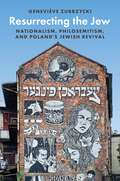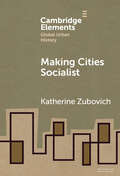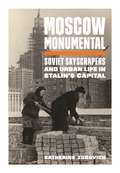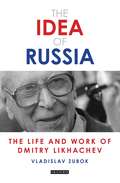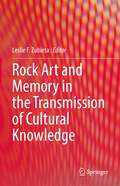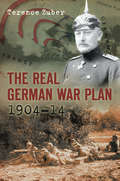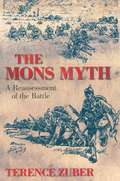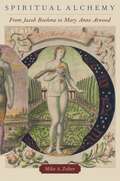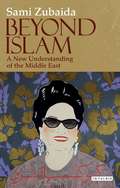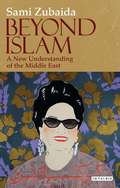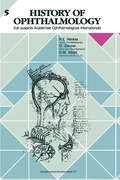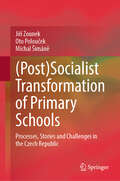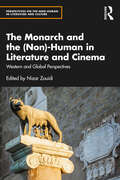- Table View
- List View
Resurrecting the Jew: Nationalism, Philosemitism, and Poland’s Jewish Revival (Princeton Studies in Cultural Sociology #18)
by Geneviève ZubrzyckiAn in-depth look at why non-Jewish Poles are trying to bring Jewish culture back to life in Poland todaySince the early 2000s, Poland has experienced a remarkable Jewish revival, largely driven by non-Jewish Poles with a passionate new interest in all things Jewish. Klezmer music, Jewish-style restaurants, kosher vodka, and festivals of Jewish culture have become popular, while new museums, memorials, Jewish studies programs, and Holocaust research centers reflect soul-searching about Polish-Jewish relations before, during, and after the Holocaust. In Resurrecting the Jew, Geneviève Zubrzycki examines this revival and asks what it means to try to bring Jewish culture back to life in a country where 3 million Jews were murdered and where only about 10,000 Jews now live.Drawing on a decade of participant-observation in Jewish and Jewish-related organizations in Poland, a Birthright trip to Israel with young Polish Jews, and more than a hundred interviews with Jewish and non-Jewish Poles engaged in the Jewish revival, Resurrecting the Jew presents an in-depth look at Jewish life in Poland today. The book shows how the revival has been spurred by progressive Poles who want to break the association between Polishness and Catholicism, promote the idea of a multicultural Poland, and resist the Far Right government. The book also raises urgent questions, relevant far beyond Poland, about the limits of performative solidarity and empathetic forms of cultural appropriation.
Making Cities Socialist (Elements in Global Urban History)
by null Katherine ZubovichThis Element explores the history of urban planning, city building, and city life in the socialist world. It follows the global trajectories of architects, planners, and ideas about socialist urbanism developed during the twentieth century, while also highlighting features of everyday life in socialist cities. The Element opens with a section on the socialist city as it took shape first in the Soviet Union. Subsequent sections take a comparative and transnational approach to the history of socialist urbanism, tracing socialist city development in the Union of Soviet Socialist Republics (USSR), Eastern Europe, Asia, Africa, and Latin America.
Moscow Monumental: Soviet Skyscrapers and Urban Life in Stalin's Capital
by Katherine ZubovichAn in-depth history of the Stalinist skyscraperIn the early years of the Cold War, the skyline of Moscow was forever transformed by a citywide skyscraper building project. As the steel girders of the monumental towers went up, the centuries-old metropolis was reinvented to embody the greatness of Stalinist society. Moscow Monumental explores how the quintessential architectural works of the late Stalin era fundamentally reshaped daily life in the Soviet capital.Drawing on a wealth of original archival research, Katherine Zubovich examines the decisions and actions of Soviet elites—from top leaders to master architects—and describes the experiences of ordinary Muscovites who found their lives uprooted by the ambitious skyscraper project. She shows how the Stalin-era quest for monumentalism was rooted in the Soviet Union's engagement with Western trends in architecture and planning, and how the skyscrapers required the creation of a vast and complex infrastructure. As laborers flooded into the city, authorities evicted and rehoused tens of thousands of city residents living on the plots selected for development. When completed in the mid-1950s, these seven ornate neoclassical buildings served as elite apartment complexes, luxury hotels, and ministry and university headquarters.Moscow Monumental tells a story that is both local and broadly transnational, taking readers from the streets of interwar Moscow and New York to the marble-clad halls of the bombastic postwar structures that continue to define the Russian capital today.
Collapse: The Fall of the Soviet Union
by Vladislav M. ZubokA major study of the collapse of the Soviet Union—showing how Gorbachev’s misguided reforms led to its demiseIn 1945 the Soviet Union controlled half of Europe and was a founding member of the United Nations. By 1991, it had an army four-million strong, five-thousand nuclear-tipped missiles, and was the second biggest producer of oil in the world. But soon afterward the union sank into an economic crisis and was torn apart by nationalist separatism. Its collapse was one of the seismic shifts of the twentieth century. Thirty years on, Vladislav Zubok offers a major reinterpretation of the final years of the USSR, refuting the notion that the breakup of the Soviet order was inevitable. Instead, Zubok reveals how Gorbachev’s misguided reforms, intended to modernize and democratize the Soviet Union, deprived the government of resources and empowered separatism. Collapse sheds new light on Russian democratic populism, the Baltic struggle for independence, the crisis of Soviet finances—and the fragility of authoritarian state power.
A Failed Empire: The Soviet Union in the Cold War from Stalin to Gorbachev (The New Cold War History)
by Vladislav M. ZubokIn this widely praised book, Vladislav Zubok argues that Western interpretations of the Cold War have erred by exaggerating either the Kremlin's pragmatism or its aggressiveness. Explaining the interests, aspirations, illusions, fears, and misperceptions of the Kremlin leaders and Soviet elites, Zubok offers a Soviet perspective on the greatest standoff of the twentieth century. Using recently declassified Politburo records, ciphered telegrams, diaries, and taped conversations, among other sources, Zubok offers the first work in English to cover the entire Cold War from the Soviet side. A Failed Empire provides a history quite different from those written by the Western victors. In a new preface for this edition, the author adds to our understanding of today's events in Russia, including who the new players are and how their policies will affect the state of the world in the twenty-first century.
The Idea of Russia: The Life and Work of Dmitry Likhachev (Library of Modern Russia)
by Vladislav ZubokDmitry Likhachev (1906-1999) was one of the most prominent Russian intellectuals of the twentieth century. His life spanned virtually the entire century – a tumultuous period which saw Russia move from Tsarist rule under Nicholas II via the Russian Revolution and Civil War into seven decades of communism followed by Gorbachev's Perestroika and the rise of Putin. In 1928, shortly after completing his university education, Likhachev was arrested, charged with counter-revolutionary ideas and imprisoned in the Gulag, where he spent the next five years. Returning to a career in academia, specialising in Old Russian literature, Likhachev played a crucial role in the cultural life of twentieth-century Russia, campaigning for the protection of important cultural sites and historic monuments. He also founded museums dedicated to great Russian writers including Dostoevsky, Pushkin and Pasternak. In this, the first biography of Likhachev to appear in English, Vladislav Zubok provides a thoroughly-researched account of one of Russia's most extraordinary and influential public figures.
Rock Art and Memory in the Transmission of Cultural Knowledge
by Leslie F. ZubietaThis book shares timely and thought-provoking methodological and theoretical approaches from perspectives concerning landscape, gender, cognition, neural networks, material culture and ontology in order to comprehend rock art’s role in memorisation processes, collective memory, and the intergenerational circulation of knowledge. The case studies offered here stem from human experiences from around the globe—Africa, Australia, Europe, North and South America—, which reflects the authors’ diverse interpretative stances. While some of the approaches deal with mnemonics, new digital technologies and statistical analysis, others examine performances, sensory engagement, language, and political disputes, giving the reader a comprehensive view of the myriad connections between memory studies and rock art. Indigenous interlocutors participate as collaborators and authors, creating space for Indigenous narratives of memory. These narratives merge with Western versions of past and recent memories in order to construct jointly novel inter-epistemic understandings of images made on rock. Each chapter demonstrates the commitment of rock art studies to strengthen and enrich the field by exploring how communities and cultures across time have perceived and entangled rock images with a broad range of material culture, nonhumans, people, emotions, performances, sounds and narratives. Such relations are pivotal to understanding the universe behind the intersections of memory and rock art and to generating future interdisciplinary collaborative studies.
The Real German War Plan, 1904-14: 1904-14
by Terernce ZuberThe Real German War Plan, 1904-14 fundamentally changes our understanding of German military planning before the First World War. On the basis of newly discovered or long-neglected documents in German military archives, this book gives the first description of Schlieffen's war plans in 1904 and 1905 and Moltke's plans from 1906 to 1914. It explodes unfounded myths concerning German war planning, gives the first appraisal of the actual military and political factors that influenced it, shows that there never was a 'Schlieffen Plan' and reveals Moltke's strategy for a war against Russia from 1909 to 1912. Tracing the decline in the German military position and the recognition by 1913 that Germany would be forced to fight outnumbered on both the eastern and western fronts, it is an essential read for anyone with an interest in the First World War.
The Battle of the Frontiers: Ardennes 1914 (Battles And Campaigns Ser.)
by Terence ZuberLike the Battle of Verdun, the Battle of the Frontiers has often been ignored by military historians, who assumed that the French lost the first battles of the World War I because they launched suicidal bayonet charges against German machine guns. Therefore, for nearly a century, these battles have been considered uninteresting. In reality, these were some of the most important, hard-fought and instructive battles of the First World War. The Battle of the Frontiers is the first history of this battle in English and is based on ground-breaking research conducted in French and German army archives. It also makes use of neglected French and German books and articles, as well as German regimental histories, and includes personal accounts by participants such as Manfred von Richthofen (when he was still a cavalry lieutenant) and the young Erwin Rommel. Terence Zuber here presents a dramatic new perspective on combat in 1914.
The Mons Myth: A Reassessment of the Battle
by Terence ZuberConventional histories of the Battles of Mons and Le Cateau describe how, although the British were massively outnumbered, precise and rapid rifle fire mowed down rows of German troops: the staggering casualties inflicted made both British victories, and set the stage for the Battle of the Marne. But neither encounter has ever been described in English from the German point of view. Using German tactics manuals and regimental histories, Terence Zuber re-examines the battles at Mons and Le Cateau, subjecting British tactics to a critique that goes beyond admiration for rapid rifle fire and presenting new and startling perspectives, showing how the Germans employed a high degree of tactical sophistication in conducting combined-arms operations. The odds were, in fact, even, and German casualties never reached the levels described in the standard histories. 'The Mons Myth' is the first history of these battles to take this approach in ninety years, and completely changes our understanding of what actually happened.
Ten Days in August: The Siege of Liège 1914
by Terence ZuberIn August 1914 the German main attack was conducted by the 2nd Army. It had the missions of taking the vital fortresses of Liège and Namur, and then defeating the Anglo-French-Belgian forces in the open plains of northern Belgium. The German attack on the Belgian fortress at Liège from 5 to 16 August 1914 had tremendous political and military importance. Nevertheless, there has never been a complete account of the siege of Liège. The German and Belgian sources are fragmentary and biased. The short descriptions in English are general, use a few Belgian sources, and are filled with inaccuracies. Making professional military use of both German and Belgian sources, this book for the first time describes and evaluates the construction of the fortress, its military purpose, the German plan, and the conduct of the German attack on the night of 5-6 August. Previous accounts emphasize the importance of the huge German “Big Bertha” cannon, to the virtual exclusion of everything else: the Siege of Liège shows that the effect of this gun was a myth, and shows how the Germans really took the fortress. This is how the whole bloody mess started.
Spiritual Alchemy: From Jacob Boehme to Mary Anne Atwood (Oxford Studies in Western Esotericism)
by Mike A. ZuberMost professional historians see the relationship between pre-modern and modern alchemy as one of discontinuity and contrast. Mike A. Zuber challenges this dominant understanding and explores aspects of alchemy that have been neglected by recent work in the history of science. The predominant focus on the scientific aspect of alchemy, such as laboratory experiment, practical techniques, and material ingredients, argues Zuber, marginalizes the things that render alchemy so fascinating: its rich and vivid imagery, reliance on the medium of manuscript, and complicated relationship with religion. Spiritual Alchemy traces the early-modern antecedents of modern alchemy through generations of followers of Jacob Boehme, the cobbler and theosopher of Görlitz. As Boehme's disciples down the generations -- including the Silesian nobleman Abraham von Franckenberg and the London-based German immigrant Dionysius Andreas Freher, among others -- studied his writings, they drew on his spiritual alchemy, adapted it, and communicated it to their contemporaries. Spiritual alchemy combines traditional elements of alchemical literature with Christian mysticism. Defying the boundaries between science and religion, this combination was transmitted from Görlitz ultimately to England. In 1850, it inspired a young woman, later known as Mary Anne Atwood, to write her Suggestive Inquiry into the Hermetic Mystery, usually seen as the first modern interpretation of alchemy. Drawing extensively on manuscript or otherwise obscure sources, Zuber documents continuity between pre-modern and modern forms of alchemy while exploring this hybrid phenomenon.
Spiritual Alchemy: From Jacob Boehme to Mary Anne Atwood (Oxford Studies in Western Esotericism)
by Mike A. ZuberMost professional historians see the relationship between pre-modern and modern alchemy as one of discontinuity and contrast. Mike A. Zuber challenges this dominant understanding and explores aspects of alchemy that have been neglected by recent work in the history of science. The predominant focus on the scientific aspect of alchemy, such as laboratory experiment, practical techniques, and material ingredients, argues Zuber, marginalizes the things that render alchemy so fascinating: its rich and vivid imagery, reliance on the medium of manuscript, and complicated relationship with religion. Spiritual Alchemy traces the early-modern antecedents of modern alchemy through generations of followers of Jacob Boehme, the cobbler and theosopher of Görlitz. As Boehme's disciples down the generations -- including the Silesian nobleman Abraham von Franckenberg and the London-based German immigrant Dionysius Andreas Freher, among others -- studied his writings, they drew on his spiritual alchemy, adapted it, and communicated it to their contemporaries. Spiritual alchemy combines traditional elements of alchemical literature with Christian mysticism. Defying the boundaries between science and religion, this combination was transmitted from Görlitz ultimately to England. In 1850, it inspired a young woman, later known as Mary Anne Atwood, to write her Suggestive Inquiry into the Hermetic Mystery, usually seen as the first modern interpretation of alchemy. Drawing extensively on manuscript or otherwise obscure sources, Zuber documents continuity between pre-modern and modern forms of alchemy while exploring this hybrid phenomenon.
Beyond Islam: A New Understanding of the Middle East
by Sami ZubaidaIn this magisterial work, Sami Zubaida draws on a distinguished career's worth of experience trying to understand the region to address the fundamental question in Middle East studies: what is the Middle East? He argues, controversially, that to see it through the prism of Islam, as it is conventionally viewed, is to completely misunderstand it. Many of what we think of as the 'Islamic' characteristics of the region are products of culture and society, not religion.To think of Islam itself as an essential, anti-modern force in the region rather than something shaped by specific historical-economic processes is, Zubaida argues, a mistake. Instead, he offers us an alternative view of the region, its historic cosmpolitanism, its religious and cultural diversity, its rapid adoption of new media cultures, which reveals a multi-faceted and complex region teeming with multiple identities. Wide-ranging, erudite and powerfully argued, Zubaida's work will be essential reading for future generations of students of this fascinating region.
Beyond Islam: A New Understanding of the Middle East (Library of Modern Middle East Studies)
by Sami ZubaidaIn this magisterial work, Sami Zubaida draws on a distinguished career's worth of experience trying to understand the region to address the fundamental question in Middle East studies: what is the Middle East? He argues, controversially, that to see it through the prism of Islam, as it is conventionally viewed, is to completely misunderstand it. Many of what we think of as the 'Islamic' characteristics of the region are products of culture and society, not religion. To think of Islam itself as an essential, anti-modern force in the region rather than something shaped by specific historical-economic processes is, Zubaida argues, a mistake. Instead, he offers us an alternative view of the region, its historic cosmpolitanism, its religious and cultural diversity, its rapid adoption of new media cultures, which reveals a multi-faceted and complex region teeming with multiple identities. Wide-ranging, erudite and powerfully argued, Zubaida's work will be essential reading for future generations of students of this fascinating region.
Being a Man: Negotiating Ancient Constructs of Masculinity (Studies in the History of the Ancient Near East)
by Ilona ZsolnayBeing a Man is a formative work which reveals the myriad and complex negotiations for constructions of masculine identities in the greater ancient Near East and beyond. Through a juxtaposition of studies into Neo-Assyrian artistic representations and omens, biblical hymns and narrative, Hittite, Akkadian, and Indian epic, as well as detailed linguistic studies on gender and sex in the Sumerian and Hebrew languages, the book challenges traditional understandings and assumed homogeneity for what it meant "to be a man" in antiquity. Being a Man is an indispensable resource for students of the ancient Near East, and a fascinating study for anyone with an interest in gender and sexuality throughout history.
Being a Man: Negotiating Ancient Constructs of Masculinity (Studies in the History of the Ancient Near East)
by Ilona ZsolnayBeing a Man is a formative work which reveals the myriad and complex negotiations for constructions of masculine identities in the greater ancient Near East and beyond. Through a juxtaposition of studies into Neo-Assyrian artistic representations and omens, biblical hymns and narrative, Hittite, Akkadian, and Indian epic, as well as detailed linguistic studies on gender and sex in the Sumerian and Hebrew languages, the book challenges traditional understandings and assumed homogeneity for what it meant "to be a man" in antiquity. Being a Man is an indispensable resource for students of the ancient Near East, and a fascinating study for anyone with an interest in gender and sexuality throughout history.
History of Ophthalmology 5: Sub auspiciis Academiae Ophthalmologicae Internationalis (History of Ophthalmology #5)
by Claudia Zrenner Harold E. Henkes Daniel M. AlbertHistory of Ophthalmology: Sub auspiciis Academiae Ophthalmologicae Internationalis (History of Ophthalmology #6)
by Claudia Zrenner Daniel M. AlbertHistory of Ophthalmology 4: Sub auspiciis Academiae Ophthalmologicae Intemationalis (History of Ophthalmology #4)
by Claudia Zrenner Daniel M. AlbertHistory of Ophthalmology: Sub auspiciis Academiae Ophthalmologicae Internationalis (History of Ophthalmology #7)
by Claudia Zrenner(Post)Socialist Transformation of Primary Schools: Processes, Stories and Challenges in the Czech Republic
by Jiří Zounek Oto Polouček Michal ŠimáněThis book addresses the transformation of primary education in the former Czechoslovakia (now the Czech Republic) after the fall of the communist regime in 1989. It follows the overall transformation of education and school policy and offers original insights into the everyday life of the schools at that time. It also provides a unique perspective on the whole transformation process. The work discusses the school environment in the context of specific local characteristics, such as parents, community, regional institutions, and national and international contexts. The book specifically focuses on the changes in primary school management in terms of economics, organization, and personnel. The processes of pedagogical change are an essential theme of the book. They cover how teachers proceeded through the changes in their work at the time of the transformation and the reasons for their resistance to change, including the challenges that the transformation introduced into their work and personal lives. The book also monitors how the teachers navigated the selection and use of new textbooks and tools, such as digital tools. The work originates in historical-pedagogical research, based primarily on the oral history method and complemented by the study of contemporary documents.
The Monarch and the: Western and Global Perspectives (Perspectives on the Non-Human in Literature and Culture)
by Nizar ZouidiThis collection studies the representations of the character of the monarch in literature and cinema. Being a person, an institution, a character archetype and a narrative role, the characters of the monarch and other royal or regal characters oscillate between humanity and the non-human. As such, they are hybrid forms of existence and subjectivity. The authors of this collection explore this hybridity across large spectra of genres, historical periods and cultural contexts. Some of the most prolific and widely read scholars analyze the archetype of the monarch on the page, the stage and the screen. They cover large swathes of intersecting creative and interpretive territories including ancient epic and religious poetry, Arthurian legends, British Renaissance and modern drama, British horror films and Hollywood crime and sports films. This collection also features interviews with six prominent comic book writers and artists, who discuss the influence of classical royal archetypes on their works.
Global Security Watch—The Maghreb: Algeria, Libya, Morocco, and Tunisia (Global Security Watch)
by Yahia H. Zoubir Louisa Dris-Aït-HamadoucheAn unprecedented analysis of how the liberation from colonial rule has threatened the Maghreb region of Africa and created political and social challenges that puts global security at risk.Northwestern Africa, known as the Maghreb, consists of Algeria, Libya, Mauritania, Morocco, Tunisia, and Western Sahara. Recent changes in the political climate—including the collapse of the Libyan regime in October 2011 and structural factors, such as the decolonization of the countries within the Maghreb—have escalated violence in the area, exposing global powers, including the United States, to terrorist attacks. This is the first book of its kind to focus on the strategic planning of the United States, as well as other world powers, in the stabilization of the region.Global Security Watch—The Maghreb: Algeria, Libya, Morocco, and Tunisia examines domestic, regional, and international policies as they relate to the area's culture, geography, and history. Each of the book's seven chapters looks at the political and social stability of the land, and features a discussion on such topics as interstate relations, regional integration, conflict resolution, and the legislation governing security.
Global Security Watch—The Maghreb: Algeria, Libya, Morocco, and Tunisia (Global Security Watch)
by Yahia H. Zoubir Louisa Dris-Aït-HamadoucheAn unprecedented analysis of how the liberation from colonial rule has threatened the Maghreb region of Africa and created political and social challenges that puts global security at risk.Northwestern Africa, known as the Maghreb, consists of Algeria, Libya, Mauritania, Morocco, Tunisia, and Western Sahara. Recent changes in the political climate—including the collapse of the Libyan regime in October 2011 and structural factors, such as the decolonization of the countries within the Maghreb—have escalated violence in the area, exposing global powers, including the United States, to terrorist attacks. This is the first book of its kind to focus on the strategic planning of the United States, as well as other world powers, in the stabilization of the region.Global Security Watch—The Maghreb: Algeria, Libya, Morocco, and Tunisia examines domestic, regional, and international policies as they relate to the area's culture, geography, and history. Each of the book's seven chapters looks at the political and social stability of the land, and features a discussion on such topics as interstate relations, regional integration, conflict resolution, and the legislation governing security.
